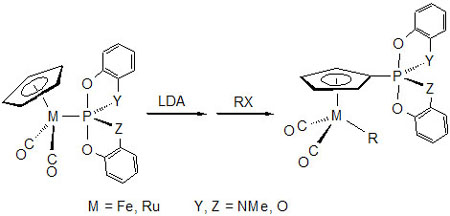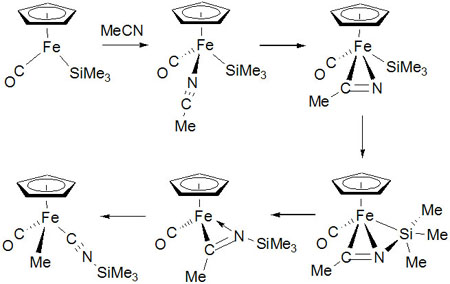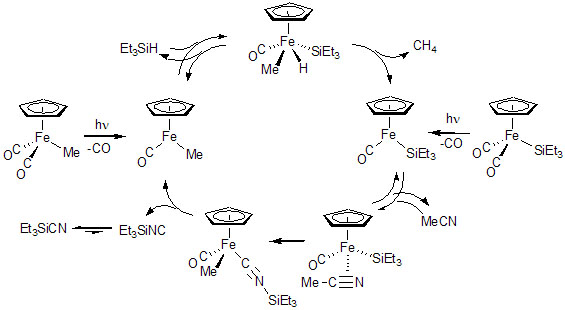1. Current Research and Principal Research Interests
The group's interests are creation of new types of complexes involving dative, covalent, double, and triple bonds between a transition metal and a main group element in groups 13 to 17, and also development of new function of these complexes. An application of the new types of complexes in catalytic systems is also the groupfs interest.
(1) Transition
Metal Complexes Containing a Phosphenium Ligand
A new method for preparation of cationic phosphenium complexes
of transition metals has been developed where an OR group on a coordinating
phosphite is abstracted as an anion by a Lewis acid such as
BF3•Et2O.

Reactions of iron
complexes containing a group 14 element ligand (ER3; E =
C, Si, Ge, Sn) and diaminosubstituted phosphite,
Cp-(CO)(ER3)Fe{PN(Me)CH2CH2NMe-(OMe)} with a Lewis acid
revealed that the reaction product depends on E. In any case, an OMe
anion abstraction by a Lewis acid uniformly takes place at the first stage
of the reaction to give a cationic phosphenium iron complex containing
an ER3 ligand. The subsequent reaction is strongly dependent
on E. When E is C, migratory insertion of the phosphenium ligand into
the Fe-C bond or more simply an alkyl migration from Fe to phosphenium
P occurs. When E is Si or Ge, the cationic phosphenium complex is stable
and Fe-Si and Fe-Ge bonds remain intact. In contrast, when E is Sn, not
SnR3 but one alkyl group on the Sn migrates to the phosphenium
P to give a stannylene complex.
(2) Metallaphosphorane Chemistry
An unprecedented method for the preparation of metallaphosphorane
was created involving nucleophilic attacks of an organic nucleophile at
a trivalent phosphorus coordinated to an iron and substitution on the
phosphorus. The character of the bond between a transition metal and a
hypervalent phosphorus was revealed.
The reaction of metallaphosphorane with a Lewis base showed the
first example of a hypervalent fragment migration, that is, phosphorane
migration from a transition metal to a cyclopentadienyl ring.

(3) C-C Bond Cleavage Reaction of Organonitriles Promoted by a Transition Metal Complex
A C-C bond in organonitrile, being relatively strong (133 kcal mol-1 for MeCN), was found to be cleaved by a transition metal silyl complex. The photoreaction of a silyl complex Cp(CO)2Fe(SiMe3) in the presence of acetonitrile produces Me3SiNC and Me3SiCN, showing that the C-C bond in MeCN is cleaved. The corresponding alkyl, germyl, and stannyl iron complexes do not cleave the C-C bond. Therefore, the silyl ligand on the iron is indispensable for the C-C bond cleavage. Theoretical studies proposed the mechanism: MeCN coordinates to the 16e species [Cp(CO)Fe(SiMe3)] in η1-fashion, and it isomerizes to η2-coordination mode. Then, the SiMe3 group migrates from Fe to N of MeCN to give a silyl imono complex, followed by the slippage of the Me-C=N portion in the coordination sphere to finally give the methyl silylisocyanide complex.

The iron complexes, [Cp(CO)2Fe(SiMe3)] and also [Cp(CO)2FeMe], serve as a catalyst for C-CN bond cleavage in the reaction of HSiEt3 with MeCN. The catalytic system can be applied for arylnitrile C-C bond cleavage. The catalytic cycle has been proposed.

2. Selected Publications
1. “Iron-catalyzed Silylcyanation of Aldehydes and Ketones with Silyl Cyanide Prepared from Silane and Acetonitrile”, M. Itazaki and H. Nakazawa, Chem. Lett., 37, 1054-1055 (2005).
2. “Catalytic C-C Bond Cleavage and C-Si Bond Formation in Reaction of RCN with Et3SiH Promoted by an Iron Complex”, H. Nakazawa, K. Kamata, and M. Itazaki, Chem. Commun., 4004-4006 (2005).
3. “Transition Metal Complexes Bearing a Phosphenium Ligand”, H. Nakazawa, Advances in Organometallic Chemistry, 50, 107-143 (2004).
4. “C-C Bond Cleavage of Acetonitrile by a Carbonyl Iron Complex with a Silyl Ligand”, H. Nakazawa, T. Kawasaki, K. Miyoshi, C. H. Suresh, and N. Koga, Organometallics, 23, 117-126 (2004).
5. “Synthesis and Characterization of Some Zirconium and Hafnium Complexes with a Phosphide-Pendant Cyclopentadienyl Ligand”, T. Ishiyama, T. Mizuta, K. Miyoshi, and H. Nakazawa, Organometallics, 22, 1096-1105 (2003).
6. “Synthesis of Group 4 Transition-metal Complexes Bearing a Secondary
Phosphine Pendant Cyclopentadienyl Ligand”, T. Ishiyama, H. Nakazawa, and K. Miyoshi, J. Organomet. Chem., 648, 231-236
(2002).
7. “Metallaphosphorane Chemistry: Preparations, Structures, and
Reactivities”, H. Nakazawa, K. Kubo, and K. Moyoshi,
Bull. Chem. Soc. Jpn., 74, 2255-2267 (2001).
8. “The Chemistry of Transition-Metal Complexes Containing a Phosphenium
Ligand”, H. Nakazawa, J. Organomet. Chem., 611, 349-363
(2000).
9. “Phosphorane Migration from Ruthenium to the Cyclopentadienyl
Ring”, H. Nakazawa, K. Kawamura, K. Kubo, and K. Miyoshi,
Organometallics, 18, 4518-4523 (1999).
10. “Migration Reaction of a Hypervalent Fragment: Base-Induced Migration
of a Phosphorane Fragment from Iron to the Cyclopentadienyl Ring in
Cp(CO)2Fe{P(OC6H4Y)(OC6H4Z)}
(Y, Z = NMe, NH, O)”, K. Kubo, H. Nakazawa, K. Kawamura,
T. Mizuta, and K. Miyoshi, J. Am. Chem. Soc., 120, 6715-6721
(1998).
|